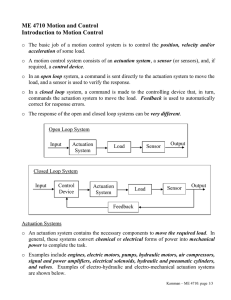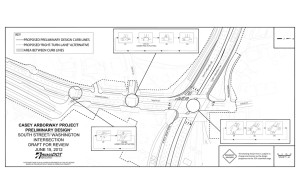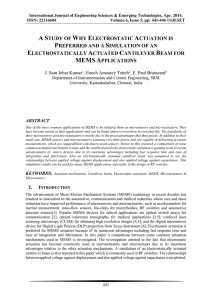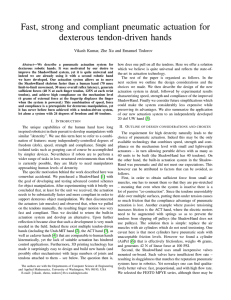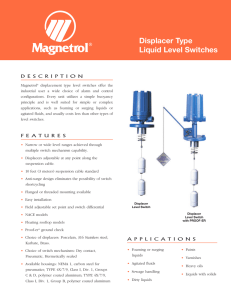Learning to Satisfy Actuator Networks Mark Coates National Science and
advertisement
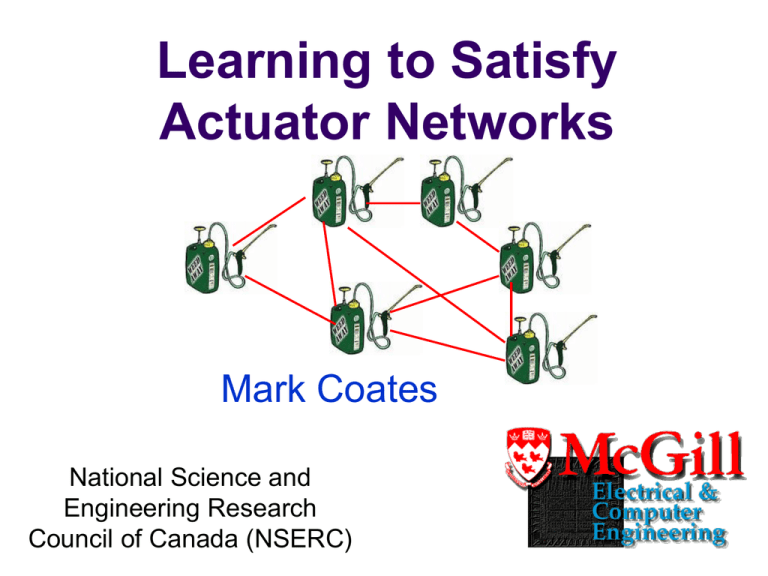
Learning to Satisfy Actuator Networks Mark Coates National Science and Engineering Research Council of Canada (NSERC) A Journey “And what is a journey? Is it just… distance traveled? Time spent? No. It's what happens on the way, the things that happen to you. At the end of the journey you're not the same.” Plan your Journey, Learn “It's what happens on the way, it the things that happen to you.” Sensor Networks Local Actuation: SANETs Control sensors, control objects. Modify the environment. Learn causal relationships between actuations and environmental (model) variables. Plan behaviour to optimize performance Sensor/Actuator Network Set of actuators ( ) + associated sensors ( ). Actuators perform a physical (modifying) action. Sensors monitor the response of the system. Quantify the net effect on the system (positive or negative) Design actuation strategy to optimize response Causal Analysis How can we infer the impact of an actuation based on a set of observations? In particular, how do we derive: Manipulated Probability P(Y | X := x, Z=z) From (observations based on) Unmanipulated Probability P(Y | X = x, Z=z) Example Problem We wish to evaluate the average effectiveness of a fertilizer Local background variables (for example soil moisture, temperature, salinity, weed density) affect: The successful reception of the fertilizer The impact of the fertilizer on the crop Causal Graph uj : local realizations of background variables with global distribution g zj : action by actuator (0/1 = off/on) [known or measured] dj : actuation received (0/1 = no/yes) [unobserved] yj : response (0/1 = negative/positive) [unobserved] xj , wj: observed measurements, dependent on dj and yj. Average Causal Effect (ACE) Expectation (over latent variables) of: [ Prob. of positive response given fertilizer ― Prob. of positive response without fertilizer ] ACE ( D Y ) Eu p( y1 d1 , u ) p( y1 | d0 , u ) Model the mapping not the variable Problem: Latent variables u can be high dimensional; Probability distribution g(u) can have complex structure. Approach: We have binary variables Z, D, Y We don’t care about the value of uj and how that directly influences dj What we do care about is how u impacts the mappings ZD and DY New Causal Graph cr: sixteen states c= 0: inhibit 1: pass 2: flip 3: activate g crj zj dj Much easier to estimate this distribution xj ACE ( D Y ) p(cr ( s,1)) p(cr (s, 2)) s yj wj Evaluating ACE Estimate ACE by applying distributed EM algorithm across the graphical model (model g(cr) as multinomial) Locally maximize the likelihood function: L z, d, w, y | ACE( D Y ) Expectation: calculate expected crj at each node Maximization: average the expected cri to estimate g(cr). Sensor Network Evaluation Tree network topology: An efficient mechanism for data aggregation and dissemination. Data aggregation (bottom-up) Leaf nodes: Transmit E[crj] to parent node Parent node: Performs aggregation and relays result to its own parent Root node: Performs maximization Result dissemination (top-down) Each node broadcasts result to its children nodes Influencing the Environment Design an actuation strategy Possible Objectives: Set of decision rules Map from (current and past) sensor measurements to an actuation Maximize expected response of system Provide probabilistic bounds on worst-case behaviour Possible Scenarios Accurate models of probability distributions Bayesian networks Uninformative models Learning approaches Problem Formulation Epoch of T discrete time intervals At times t = 0,…,T, node i measures a set of (i ) environmental variables Vt (i ) t Chooses an actuation A belonging to a discrete set of actuations At the end of the epoch, measure a local response variable Y ( i ) T Maximization Approach Single binary actuation decision without a good model of p(y|v,a) Consider p(y|v,a) = f(y|v,a) + n(v,a) We have a set of points (vi,ai,yi) and want to learn the best actuation strategy A(v), i.e., that which maximizes f(y|v,a). Approach: regression + subsequent maximization Robustness concerns Maximization amplifies regression errors. Multi-stage planning implies repeated regression + maximization Proliferation of error Relaxed Problem Identify the largest set of environmental conditions and actuations such that: Expected response exceeds threshold Probability of terrible response is very low LSAT Formulation Learning to Satisfy (LSAT) Given points that solves: X i , Yi i1 N P max (G ) subject to Ci (G, P) 0 where Ci(G,P) are constraints. find the set G i 1,..., K Two types of constraints Point-wise constraints: C(G,P) = C(x,G,P) is a function of the input variable x and the constraint takes the form Ci ( x, G, P) 0 x G Example: min xG E[Y | X x] U Set-average constraints: C(G,P) > 0 is only satisfied on-average over the entire set. Example: P(Y L | X G ) p Solution Cˆi (G) Derive equivalent empirical constraints Consider solution to empirical constraints Gˆ arg max (G) subject to Cˆi (G) i 1,..., K If empirical constraints are close to ideal constraints then solution is satisfactory. Algorithm: extension of support vector machine Lagrangian formulation allocating different penalties to violations of individual constraints. Comments Actuator networks present a host of problems Assessment of whether causal relationships exist and evaluation of their strength Design of actuation strategies that yield a satisfactory (optimal?) environmental response These problems are difficult in a centralized setting – the extension to distributed algorithms poses an even greater challenge.

